Quantifying City- and Street-Scale Urban Tree Phenology from Landsat-8, Sentinel-2, and PlanetScope Images: A Case Study in Downtown Beijing
Abstract
1. Introduction
2. Materials and Methods
2.1. Datasets
2.2. Study Area
2.3. Data Analysis
2.3.1. Phenology Modeling
2.3.2. City-Scale Vegetation Phenology Comparison
2.3.3. Pixel-Level Phenology Comparison
2.3.4. Street-Scale Tree Genus Phenology Comparison
3. Results
3.1. Correlations in the Spatial Distribution of NDVI in Downtown Beijing
3.2. City-Scale Vegetation Phenology in Downtown Beijing, Inferred from PlanetScope, Landsat-8, and Sentinel-2
3.3. Pixel-Level Growth Period Phenology
3.4. Street-Scale Tree Genus Phenology Comparison
4. Discussion
4.1. Dataset Selection for Urban Tree Phenology Analysis
4.2. Result Interpretation
4.3. Implications on Urban Environmental Planning
5. Conclusions
Author Contributions
Funding
Data Availability Statement
Acknowledgments
Conflicts of Interest
Appendix A
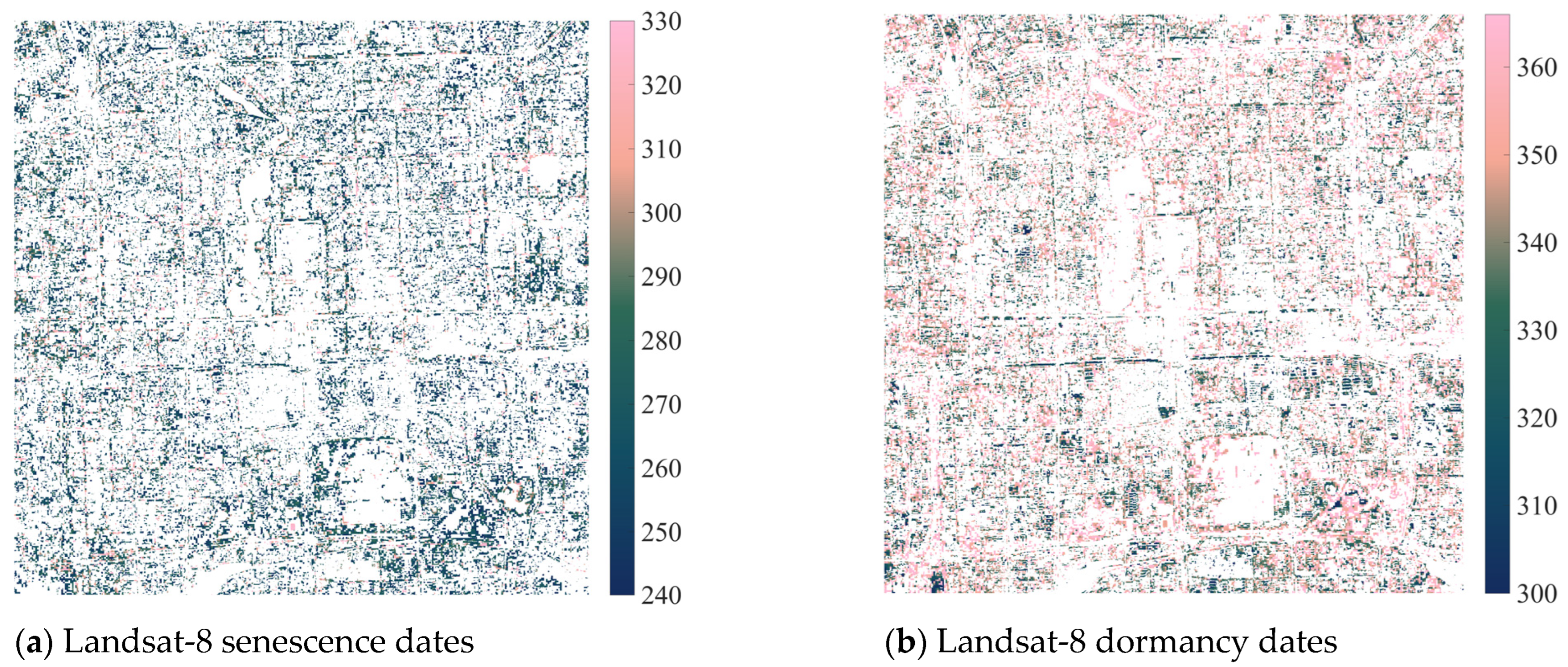
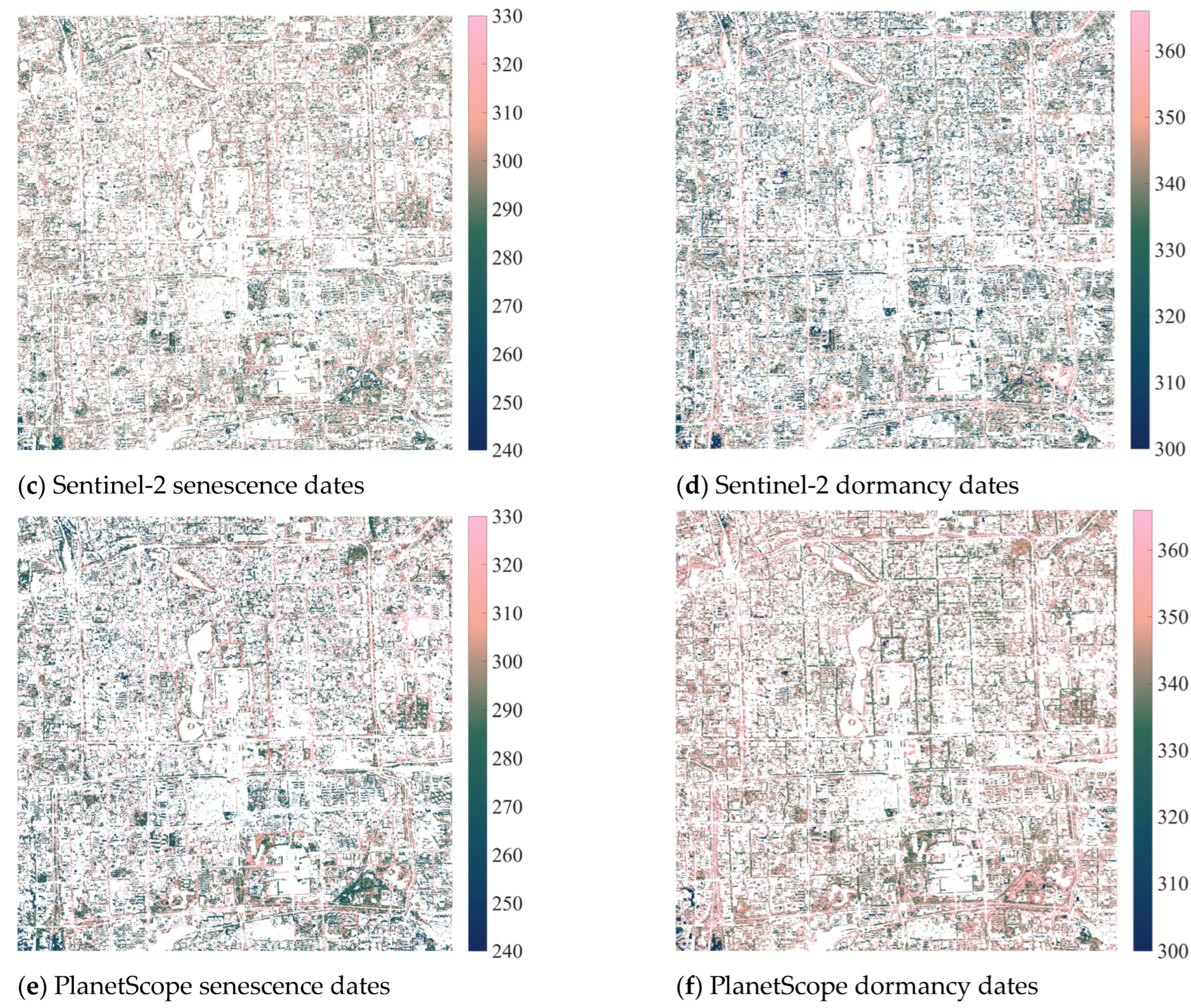
| Filtering Criteria | Landsat-8 and Sentinel-2 (senescence) | Sentinel-2 and PlanetScope (senescence) | PlanetScope and Landsat-8 (senescence) |
| NDVI > 0.3, SVR > 1.5 | 0.06 | 0.16 | 0.13 |
| NDVI > 0.5, SVR > 1.5 | 0.07 | 0.19 | 0.15 |
| NDVI > 0.7, SVR > 1.5 | 0.05 | 0.30 | 0.10 |
| Filtering Criteria | Landsat-8 and Sentinel-2 (dormancy) | Sentinel-2 and PlanetScope (dormancy) | PlanetScope and Landsat-8 (dormancy) |
| NDVI > 0.3, SVR > 1.5 | 0.05 | 0.04 | 0.02 |
| NDVI > 0.5, SVR > 1.5 | 0.07 | 0.13 | 0.05 |
| NDVI > 0.7, SVR > 1.5 | 0.22 | 0.37 | 0.19 |
References
- Zhou, Y. Understanding urban plant phenology for sustainable cities and planet. Nat. Clim. Chang. 2022, 12, 302–304. [Google Scholar] [CrossRef]
- Bowler, D.E.; Buyung-Ali, L.; Knight, T.M.; Pullin, A.S. Urban greening to cool towns and cities: A systematic review of the empirical evidence. Landsc. Urban Plan. 2010, 97, 147–155. [Google Scholar] [CrossRef]
- Rötzer, T.; Moser-Reischl, A.; Rahman, M.A.; Hartmann, C.; Paeth, H.; Pauleit, S.; Pretzsch, H. Urban tree growth and ecosystem services under extreme drought. Agric. For. Meteorol. 2021, 308, 108532. [Google Scholar] [CrossRef]
- Davies, Z.G.; Dallimer, M.; Edmondson, J.L.; Leake, J.R.; Gaston, K.J. Identifying potential sources of variability between vegetation carbon storage estimates for urban areas. Environ. Pollut. 2013, 183, 133–142. [Google Scholar] [CrossRef] [PubMed]
- Yang, J.; Chang, Y.; Yan, P. Ranking the suitability of common urban tree species for controlling PM2.5 pollution. Atmos. Pollut. Res. 2015, 6, 267–277. [Google Scholar] [CrossRef]
- Roy, S.; Byrne, J.A.; Pickering, C. A systematic quantitative review of urban tree benefits, costs, and assessment methods across cities in different climatic zones. Urban For. Urban Green. 2012, 11, 351–363. [Google Scholar] [CrossRef]
- Kowarik, I. Novel urban ecosystems, biodiversity, and conservation. Environ. Pollut. 2011, 159, 1974–1983. [Google Scholar] [CrossRef]
- Fischer, L.K.; Honold, J.; Botzat, A.; Brinkmeyer, D.; Cvejić, R.; Delshammar, T.; Elands, B.; Haase, D.; Kabisch, N.; Karle, S.J.; et al. Recreational ecosystem services in European cities: Sociocultural and geographic context matters for park use. Ecosyst. Serv. 2018, 31, 455–467. [Google Scholar] [CrossRef]
- McCormack, G.R.; Rock, M.; Toohey, A.M.; Hignell, D. Characteristics of urban parks associated with park use and physical activity: A review of qualitative research. Health Place 2010, 16, 712–726. [Google Scholar] [CrossRef]
- Cariñanos, P.; Casares-Porcel, M. Urban green zones and related pollen allergy: A review. Some guidelines for designing spaces with low allergy impact. Landsc. Urban Plan. 2011, 101, 205–214. [Google Scholar] [CrossRef]
- Shen, M.; Jiang, N.; Peng, D.; Rao, Y.; Huang, Y.; Fu, Y.H.; Yang, W.; Zhu, X.; Cao, R.; Chen, X.; et al. Can changes in autumn phenology facilitate earlier green-up date of northern vegetation? Agric. For. Meteorol. 2020, 291, 108077. [Google Scholar] [CrossRef]
- Ganguly, S.; Friedl, M.A.; Tan, B.; Zhang, X.; Verma, M. Land surface phenology from MODIS: Characterization of the Collection 5 global land cover dynamics product. Remote Sens. Environ. 2010, 114, 1805–1816. [Google Scholar] [CrossRef]
- Ge, W.; Han, J.; Zhang, D.; Wang, F. Divergent impacts of droughts on vegetation phenology and productivity in the Yungui Plateau, southwest China. Ecol. Indic. 2021, 127, 107743. [Google Scholar] [CrossRef]
- Li, X.; Zhou, Y.; Asrar, G.R.; Meng, L. Characterizing spatiotemporal dynamics in phenology of urban ecosystems based on Landsat data. Sci. Total Environ. 2017, 605–606, 721–734. [Google Scholar] [CrossRef] [PubMed]
- Wu, L.; Ma, X.; Dou, X.; Zhu, J.; Zhao, C. Impacts of climate change on vegetation phenology and net primary productivity in arid Central Asia. Sci. Total Environ. 2021, 796, 149055. [Google Scholar] [CrossRef] [PubMed]
- Li, L.; Li, X.; Asrar, G.; Zhou, Y.; Chen, M.; Zeng, Y.; Li, X.; Li, F.; Luo, M.; Sapkota, A.; et al. Detection and attribution of long-term and fine-scale changes in spring phenology over urban areas: A case study in New York State. Int. J. Appl. Earth Obs. Geoinf. 2022, 110, 102815. [Google Scholar] [CrossRef]
- Hu, P.; Sharifi, A.; Tahir, M.N.; Tariq, A.; Zhang, L.; Mumtaz, F.; Shah, S.H.I.A. Evaluation of Vegetation Indices and Phenological Metrics Using Time-Series MODIS Data for Monitoring Vegetation Change in Punjab, Pakistan. Water 2021, 13, 2550. [Google Scholar] [CrossRef]
- Zhang, Y.; Yin, P.; Li, X.; Niu, Q.; Wang, Y.; Cao, W.; Huang, J.; Chen, H.; Yao, X.; Yu, L.; et al. The divergent response of vegetation phenology to urbanization: A case study of Beijing city, China. Sci. Total Environ. 2022, 803, 150079. [Google Scholar] [CrossRef] [PubMed]
- Wang, L.; De Boeck, H.J.; Chen, L.; Song, C.; Chen, Z.; McNulty, S.; Zhang, Z. Urban warming increases the temperature sensitivity of spring vegetation phenology at 292 cities across China. Sci. Total Environ. 2022, 834, 155154. [Google Scholar] [CrossRef]
- Li, F.; Song, G.; Liujun, Z.; Yanan, Z.; Di, L. Urban vegetation phenology analysis using high spatio-temporal NDVI time series. Urban For. Urban Green. 2017, 25, 43–57. [Google Scholar] [CrossRef]
- Qiu, T.; Song, C.; Li, J. Impacts of Urbanization on Vegetation Phenology over the Past Three Decades in Shanghai, China. Remote Sens. 2017, 9, 970. [Google Scholar] [CrossRef]
- Wang, H.; Zeng, Z.-C. Satellite Observations of Urban Greenery Phenology in Downtown Beijing at Meter to Kilometer Scales. In Proceedings of the IGARSS 2022–2022 IEEE International Geoscience and Remote Sensing Symposium, Geoscience and Remote Sensing Symposium, Kuala Lumpur, Malaysia, 17–22 July 2022; pp. 6268–6271. [Google Scholar] [CrossRef]
- Planet Labs. Real-Time Satellite Monitoring with Planet. Available online: https://www.planet.com/products/monitoring/ (accessed on 19 August 2023).
- Moon, M.; Richardson, A.D.; Friedl, M.A. Multiscale assessment of land surface phenology from harmonized Landsat 8 and Sentinel-2, PlanetScope, and PhenoCam imagery. Remote Sens. Environ. 2021, 266, 112716. [Google Scholar] [CrossRef]
- Wu, S.; Wang, J.; Yan, Z.; Song, G.; Chen, Y.; Ma, Q.; Deng, M.; Wu, Y.; Zhao, Y.; Guo, Z.; et al. Monitoring tree-crown scale autumn leaf phenology in a temperate forest with an integration of PlanetScope and drone remote sensing observations. ISPRS J. Photogramm. Remote Sens. 2021, 171, 36–48. [Google Scholar] [CrossRef]
- Myers, E.; Kerekes, J.; Daughtry, C.; Russ, A. Assessing the impact of satellite revisit rate on estimation of corn phenological transition timing through shape model fitting. Remote Sens. 2019, 11, 2558. [Google Scholar] [CrossRef]
- Perry, E.; Sheffield, K.; Crawford, D.; Akpa, S.; Clancy, A.; Clark, R. Spatial and Temporal Biomass and Growth for Grain Crops Using NDVI Time Series. Remote Sens. 2022, 14, 3071. [Google Scholar] [CrossRef]
- John, A.; Ong, J.; Theobald, E.J.; Olden, J.D.; Tan, A.; Hillerislambers, J. Detecting montane flowering phenology with cubesat imagery. Remote Sens. 2020, 12, 2894. [Google Scholar] [CrossRef]
- Chen, B.; Jin, Y.; Brown, P. An enhanced bloom index for quantifying floral phenology using multi-scale remote sensing observations. ISPRS J. Photogramm. Remote Sens. 2019, 156, 108–120. [Google Scholar] [CrossRef]
- Wang, J.; Yang, M.; Chen, Z.; Lu, J.; Zhang, L. An MLC and U-Net Integrated Method for Land Use/Land Cover Change Detection Based on Time Series NDVI-Composed Image from PlanetScope Satellite. Water 2022, 14, 3363. [Google Scholar] [CrossRef]
- Alonzo, M.; Baker, M.E.; Caplan, J.S.; Williams, A.; Elmore, A.J. Canopy composition drives variability in urban growth period length more than the heat island effect. Sci. Total Environ. 2023, 884, 163818. [Google Scholar] [CrossRef]
- Google Earth Engine. A Planetary-Scale Platform for Earth Science Data & Analysis. Available online: https://earthengine.google.com (accessed on 23 June 2024).
- Planet Labs. Planet Explorer. Available online: https://www.planet.com/explorer/ (accessed on 2 June 2024).
- National Bureau of Statistics. 2021. Available online: https://www.stats.gov.cn/zt_18555/zdtjgz/zgrkpc/dqcrkpc/ (accessed on 23 June 2024).
- Savitzky, A.; Golay, M.J.E. Smoothing and Differentiation of Data by Simplified Least Squares Procedures. Anal. Chem. 1964, 36, 1627–1639. [Google Scholar] [CrossRef]
- Chen, J.; Jonsson, P.; Tamura, M.; Gu, Z.; Matsushita, B.; Eklundh, L. A simple method for reconstructing a high-quality NDVI time-series data set based on the Savitzky-Golay filter. Remote Sens. Environ. 2004, 91, 332–344. [Google Scholar] [CrossRef]
- Jonsson, P.; Eklundh, L. Seasonality extraction by function fitting to time-series of satellite sensor data. IEEE Trans. Geosci. Remote Sens. 2002, 40, 1824–1832. [Google Scholar] [CrossRef]
- Zhang, X.; Friedl, M.A.; Schaaf, C.B.; Strahler, A.H.; Hodges JC, F.; Gao, F.; Reed, B.C.; Huete, A. Monitoring vegetation phenology using MODIS. Remote Sens. Environ. 2003, 84, 471. [Google Scholar] [CrossRef]
- Gray, J.; Sulla-Menashe, D.; Friedl, M.A. User Guide to Collection 6.1 MODIS Land Cover Dynamics (MCD12Q2) Product. 2022. Available online: https://lpdaac.usgs.gov/documents/1417/MCD12Q2_User_Guide_V61.pdf (accessed on 23 June 2024).
- Sun, X.; Yuan, L.; Liu, M.; Liang, S.; Li, D.; Liu, L. Quantitative estimation for the impact of mining activities on vegetation phenology and identifying its controlling factors from Sentinel-2 time series. Int. J. Appl. Earth Obs. Geoinf. 2022, 111, 102814. [Google Scholar] [CrossRef]
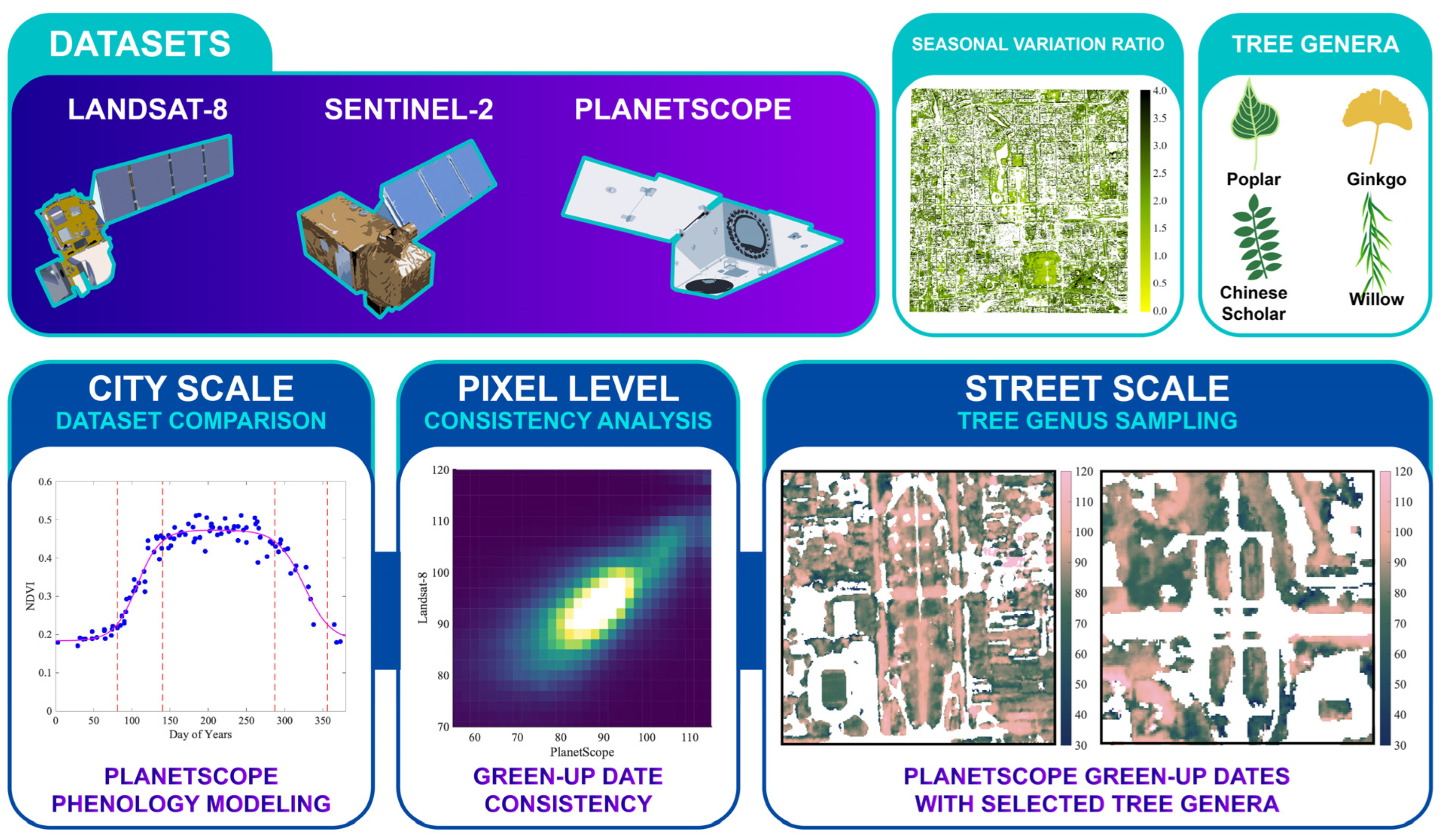
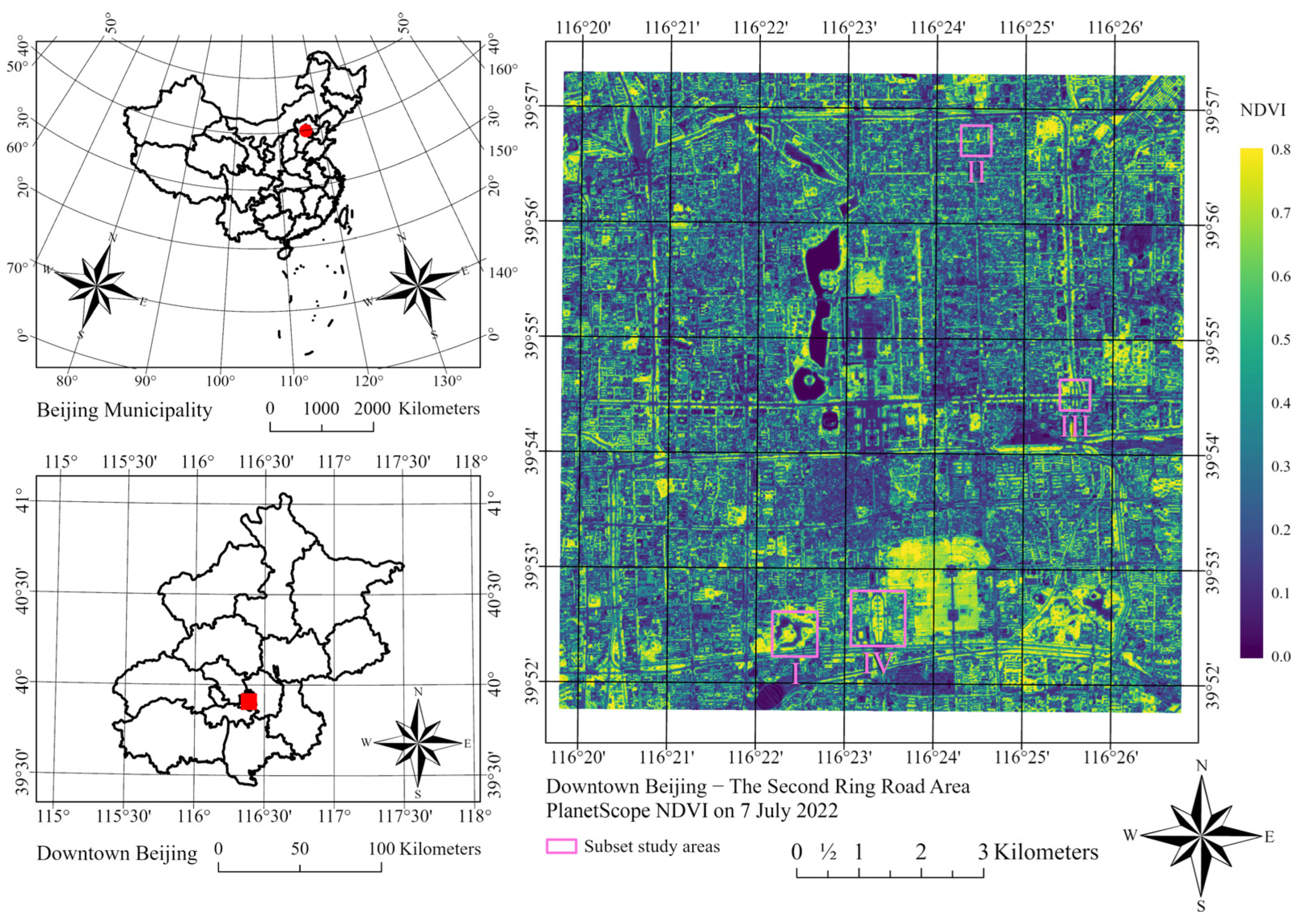




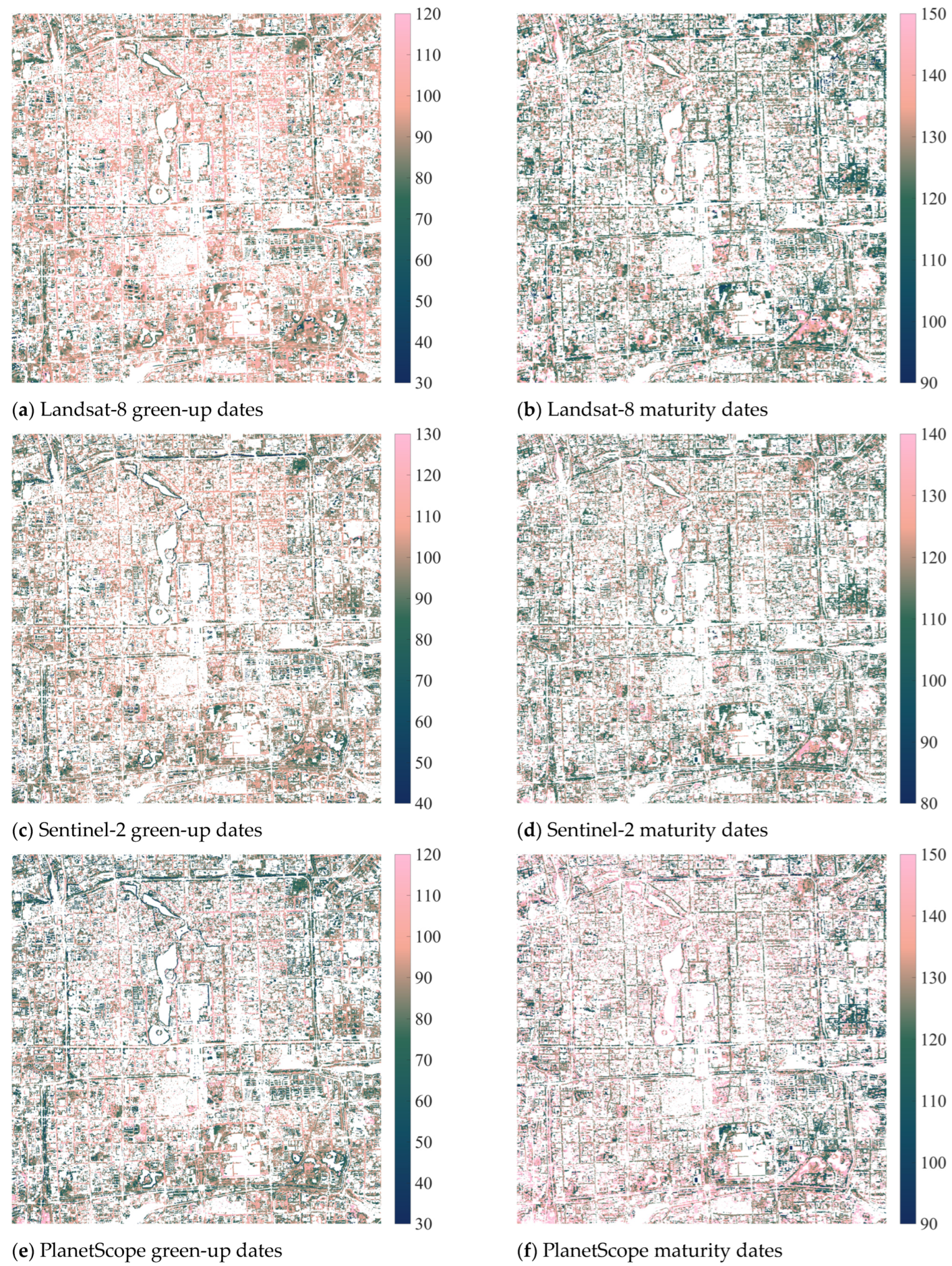
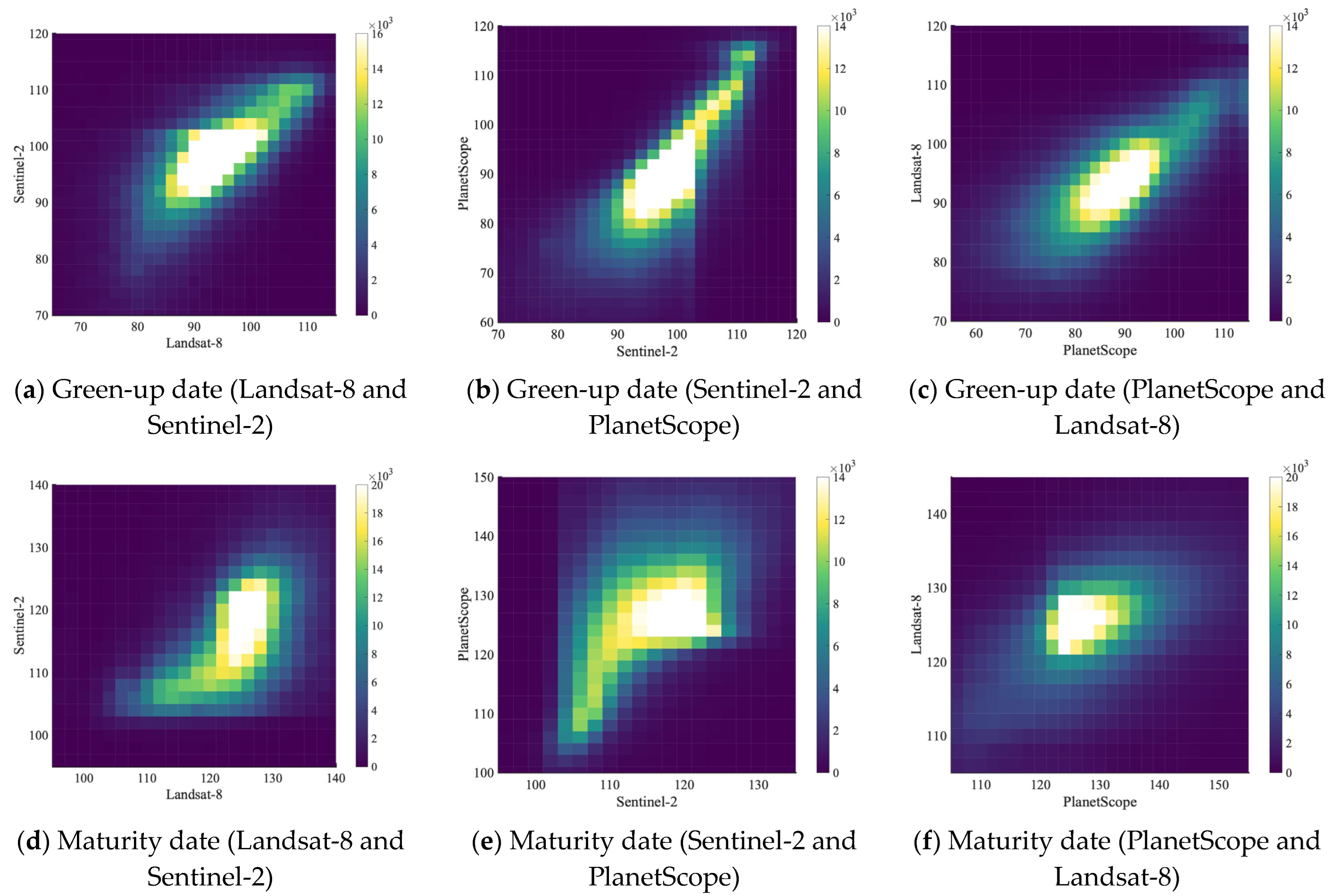
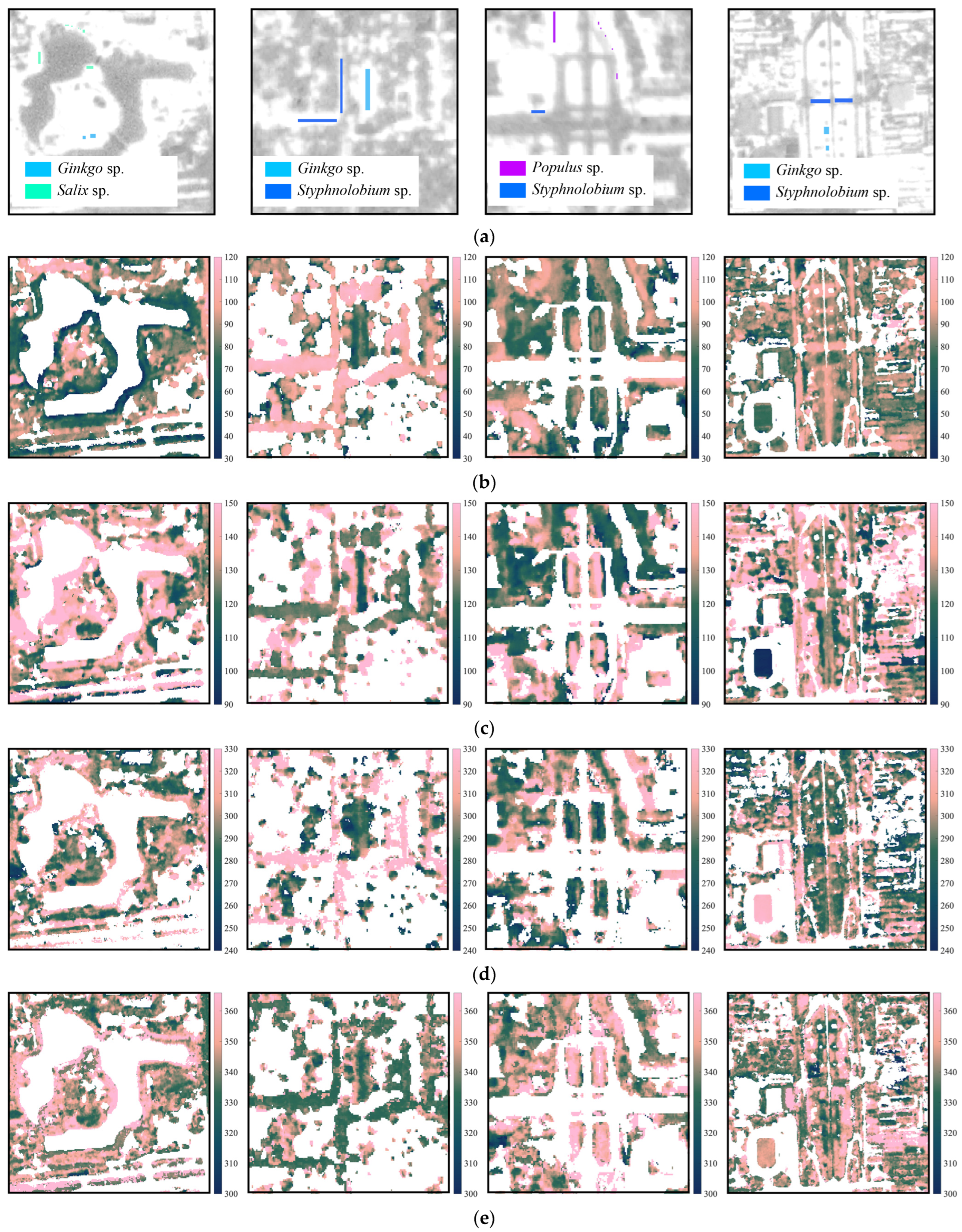

| Green-up | Maturity | Senescence | Dormancy * | Temporal Range | |
|---|---|---|---|---|---|
| Landsat-8 | 91 | 128 | 275 | 348 (331) | January 2019–February 2023 |
| 100 | 106 | 277 | 336 (323) | January 2019–February 2020 | |
| 81 | 149 | 255 | 360 (336) | January 2020–February 2021 | |
| 90 | 121 | 263 | 362 (340) | January 2021–February 2022 | |
| 98 | 122 | 264 | 341 (324) | January 2022–February 2023 | |
| Sentinel-2 | 97 | 117 | 301 | 343 (334) | January 2019–February 2023 |
| 97 | 111 | 298 | 340 (330) | January 2019–February 2020 | |
| 89 | 119 | 297 | 347 (336) | January 2020–February 2021 | |
| 95 | 121 | 303 | 328 (323) | January 2021–February 2022 | |
| 100 | 122 | 300 | 350 (339) | January 2022–February 2023 | |
| PlanetScope | 81 | 140 | 287 | 356 (340) | January 2019–February 2023 |
| 80 | 140 | 288 | 351 (337) | January 2019–February 2020 | |
| 83 | 143 | 294 | 367 (350) | January 2020–February 2021 | |
| 78 | 143 | 277 | 358 (340) | January 2021–February 2022 | |
| 84 | 138 | 272 | 352 (334) | January 2022–February 2023 |
| Filtering Criteria | Landsat-8 and Sentinel-2 (green-up) | Sentinel-2 and PlanetScope (green-up) | PlanetScope and Landsat-8 (green-up) |
| NDVI > 0.3, SVR > 1.5 | 0.22 | 0.25 | 0.20 |
| NDVI > 0.5, SVR > 1.5 | 0.29 | 0.41 | 0.34 |
| NDVI > 0.7, SVR > 1.5 | 0.34 | 0.46 | 0.32 |
| Filtering Criteria | Landsat-8 and Sentinel-2 (maturity) | Sentinel-2 and PlanetScope (maturity) | PlanetScope and Landsat-8 (maturity) |
| NDVI > 0.3, SVR > 1.5 | 0.12 | 0.15 | 0.15 |
| NDVI > 0.5, SVR > 1.5 | 0.22 | 0.26 | 0.26 |
| NDVI > 0.7, SVR > 1.5 | 0.48 | 0.50 | 0.46 |
| Populus sp. | Ginkgo sp. | Styphnolobium sp. | Salix sp. | |
|---|---|---|---|---|
| Green-up * | 90 (±2.14) | 84 (±5.07) | 101 (±5.59) | 63 (±17.33) |
| Maturity | 119 (±4.81) | 113 (±4.76) | 126 (±3.78) | 156 (±6.69) |
| Senescence | 306 (±13.13) | 290 (±5.01) | 305 (±15.71) | 267 (±11.62) |
| Dormancy * | 347 (±7.51) | 334 (±4.61) | 342 (±9.68) | 382 (±12.90) |
| Dormancy ** | 337 | 324 | 334 | 356 |
| Spring–summer growth period * | 29 days | 29 days | 25 days | 93 days |
| Maturity plateau length | 187 days | 177 days | 179 days | 111 days |
| Autumn–winter growth period * | 41 days | 44 days | 37 days | 115 days |
| Dormancy valley length * | 108–109 days | 115–116 days | 124–125 days | 46–47 days |
Disclaimer/Publisher’s Note: The statements, opinions and data contained in all publications are solely those of the individual author(s) and contributor(s) and not of MDPI and/or the editor(s). MDPI and/or the editor(s) disclaim responsibility for any injury to people or property resulting from any ideas, methods, instructions or products referred to in the content. |
© 2024 by the authors. Licensee MDPI, Basel, Switzerland. This article is an open access article distributed under the terms and conditions of the Creative Commons Attribution (CC BY) license (https://creativecommons.org/licenses/by/4.0/).
Share and Cite
Wang, H.; Gong, F.-Y. Quantifying City- and Street-Scale Urban Tree Phenology from Landsat-8, Sentinel-2, and PlanetScope Images: A Case Study in Downtown Beijing. Remote Sens. 2024, 16, 2351. https://doi.org/10.3390/rs16132351
Wang H, Gong F-Y. Quantifying City- and Street-Scale Urban Tree Phenology from Landsat-8, Sentinel-2, and PlanetScope Images: A Case Study in Downtown Beijing. Remote Sensing. 2024; 16(13):2351. https://doi.org/10.3390/rs16132351
Chicago/Turabian StyleWang, Hexiang, and Fang-Ying Gong. 2024. "Quantifying City- and Street-Scale Urban Tree Phenology from Landsat-8, Sentinel-2, and PlanetScope Images: A Case Study in Downtown Beijing" Remote Sensing 16, no. 13: 2351. https://doi.org/10.3390/rs16132351
APA StyleWang, H., & Gong, F.-Y. (2024). Quantifying City- and Street-Scale Urban Tree Phenology from Landsat-8, Sentinel-2, and PlanetScope Images: A Case Study in Downtown Beijing. Remote Sensing, 16(13), 2351. https://doi.org/10.3390/rs16132351






